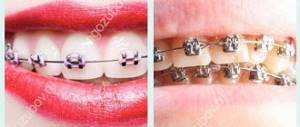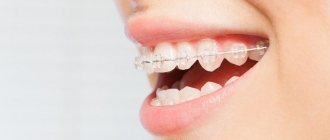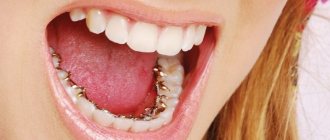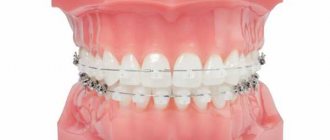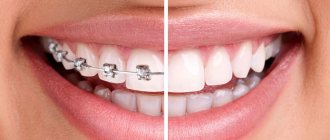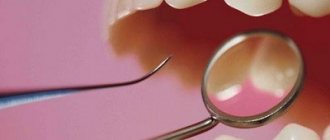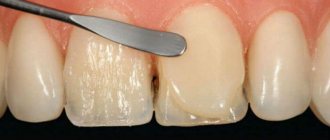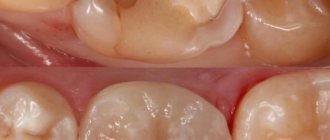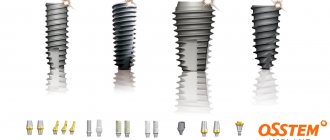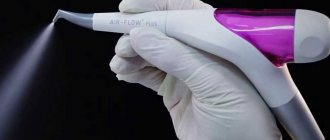Today you can correct an abnormal bite, straighten your teeth and get a beautiful smile at almost any age. The capabilities of modern orthodontics make it possible to solve even the most complex problems in children and adults. In this article we will talk about what types of braces there are and which braces are best to install.
In this article
- The best braces - what to choose?
- What do braces look like and how do they work?
- Which braces are the most effective - vestibular or lingual?
- Which is better to choose - ligature or self-ligating braces?
- How to choose braces based on material?
- How to choose effective dental braces for your child?
Classification of bracket systems
At an appointment with an orthodontist, the patient will be offered different options for braces from those that the doctor considers optimal for a particular clinical case. When choosing which braces are best to install, you should focus on the following criteria:
- — type of fixation. There are ligature and self-ligating (or non-ligating) systems;
- - material of manufacture. In dentistry, braces are made from metal, ceramics or artificial crystal (sapphire);
- - location. There are external or vestibular structures, as well as internal or lingual ones.
When choosing, you need to consider: the cost of the braces system, the dentist’s recommendations, the importance of aesthetics and strength. If you are unsure which braces system to choose, don’t be afraid to ask your doctor questions.
Best lists
The presented bracket systems are the best in their categories. But we don't want to limit your choice to just these models. Therefore, we will highlight several systems recognized as the best in the categories:
- best price;
- metal;
- invisible.
Best price
In pursuit of beauty, you should be prepared to spend money. But there are bracket systems from a fairly budget category. The most budget braces are Pilot from domestic developers. The cost starts from 12,000 rubles. The total price depends on the complexity of the curvature and the need to pre-treat the teeth. The system is simple, performs its functions perfectly, although there is a drawback - not the most aesthetic appearance.
Bracket system
Metal
We have already indicated several metal bracket systems that are considered the best in their category: Ormco (from 15,000 rubles) and Damon (from 35,000 rubles).
But there are several other metal systems that deserve attention. Empower is an American system that belongs to the category of self-ligating composite type. Cost – from 30,000 rubles. And Evolution - the development of Italian orthodontists. Relatively inexpensive (from 20,000 rubles), but reliable braces that perfectly perform their main functions and protect teeth from damage and the development of pathologies.
Bracket system
Invisible
In-Ovation-L is perhaps the best invisible braces system worth considering. The system will not let anyone understand that the patient is undergoing quite serious treatment at this moment. The cost starts from 45,000 rubles, but has many advantages: discreet treatment, absence of ligatures, comfortable wearing and robust construction.
Bracket system
Classification according to the principle of operation: ligature or non-ligature (self-ligating) braces
Depending on the type of fixation of the power arc to the clasps, braces can be ligature or non-ligature. Below we will look at the features of these two principles of system design.
Ligature braces involve the use of special elastic bands that gradually stretch. Therefore, the client has to visit the dentist monthly, or even 2 times a month, to check the tension of the arc and replace the ligatures if necessary.
Self-ligating braces (also known as non-ligating braces) - the clasps have special grooves in which the arch is fixed . This is a more modern solution that allows you to reduce the number of visits to the orthodontist to once every 2-3 months. This allows for smoother tooth movement. Also, it is easier to get used to non-ligature braces, and they help reduce treatment time and give a more predictable result.
Ligature-free braces - the new squeak of “dental fashion”
Today, non-ligating or self-ligating braces are very popular.
Their peculiarity is the absence of an additional gasket between the metal arch and the wings glued to the tooth. All structural elements are secured using special locking technology.
Such devices look lighter and weightless, and are easier to get used to. They make it easier to maintain oral hygiene. What is important is that the patient who uses them has to visit the dentist less often. The fact is that in ligature systems it is necessary to change ligatures frequently, but here there is no such need.
Ligature-free devices cope well even with complex tooth curvatures. When wearing them, bite correction occurs with less force. Also, self-ligating devices are compact, which means they cause less damage to the mucous membranes. Therefore, they can be safely called a worthy choice. At the same time, they cost about 25% more than their ligature “brothers”.
Classification by material of manufacture
When thinking about which braces to choose based on the material of manufacture, you need to know the main advantages and disadvantages of each option:
- 1. Metal . The most durable classic systems that can cope with defects of any complexity and are the cheapest. Among the disadvantages: very noticeable, even if you install a self-ligating system with small locks, they can cause allergic reactions and irritation of the mucous membranes. Common ligature systems: Mini Diamond, non-ligature systems: Damon Q, Damon 3MX.
- 2. Ceramic . Braces are much less noticeable on the teeth and do not cause allergic reactions. The most common Damon systems are highly durable and efficient. The only drawback of such systems is their high cost.
- 3. Sapphire . They are made of artificial transparent material, due to which they are almost invisible on the teeth. However, they have increased fragility, so they are not suitable for advanced defects that require long-term correction. Popular option: Inspire ICE.
If you are unsure whether to choose ceramic or metal or sapphire braces, ask our orthodontist for advice. Depending on the severity of the defect and your wishes for aesthetics and cost, the doctor will select the best option.
Active and passive self-ligation
Self-ligation can be passive or active. With the active type of fixation, the bracket clip applies pressure and moves the archwire towards the base of the slot. The orthodontic arch, in turn, puts pressure on the clip. In the case of passive self-ligation, the cover fixes the archwire in the slot without exerting pressure on it. When closed, the bracket turns into a buccal tube: the static cover becomes the fourth wall of the groove, the arch moves freely and is not subject to force. Example: Damon Q.
Damon Q with orthodontic arch
Which braces are best for adults and pediatric patients? American orthodontist Vourdouris JC compared the frictional force of the arch in the bracket groove when using passive and active non-ligature structures. According to a study published in the American J. of Orthodontics & Dentofacial orthopedics, active systems operate with a high friction force of 31.0 g, while passive designs have a low friction force of 0.1 to 0.18 g.
The data obtained scientifically prove that passive self-ligating systems are able to interact with archwires throughout treatment without loss of force and provide a new standard of low friction when moving teeth. American scientists Thorstenson GA and Kusy supplemented the results of the study. Experts have found that when using the Damon System passive self-ligating system, there is significantly lower frictional resistance in dry and wet environments compared to active structures.
Studies conducted by orthodontists indicate the benefits of treatment with passive self-ligating braces.
Classification by location: vestibular and lingual braces
Another important criterion when choosing a brace system for bite correction is the location of the locks. There are two types of systems, each of which is actively used in orthodontics:
- 1. Vestibular braces (standard, visible). Classic designs that are attached to the front surface of the teeth. These braces allow you to correct any type of malocclusion, regardless of severity and complexity. However, even the most aesthetic clasps made of ceramic or sapphire will still be noticeable on the teeth.
- 2. Lingual braces (they are also called “invisible braces”, or internal). They are installed on the inner surface of the dentition, so they are completely invisible. Minus - they have a number of restrictions for use. In particular, they are not suitable for defects that are too complex .
If you are thinking about which braces are best for a girl, a shy child or an adult, then lingual systems are best suited. However, the decision must be made together with the orthodontist.
Plastic
One of the options that was popular in the past. But with the development of other systems, it became not the most preferable. Plastic braces are used together with rubber rings - ligatures, since metal locks with grooves for the arch are not installed in them. The fact that the material is less durable than metal or ceramics does not play a big role: breaking the bracket itself is quite difficult, especially if you follow the nutritional rules. However, they do have disadvantages.
Plastic braces with colorless ligatures
pros
- Transparent or white - look more aesthetically pleasing than metal.
- You can use bright colored ligatures, but then the meaning of transparent braces is lost.
- Affordable price.
Minuses
- They work more slowly than the self-ligating system, since over time the effect of the ligatures weakens and they hold the arch less well. The arc “slides” slower than in metal grooves.
- The braces and ligatures themselves turn yellow over time due to coloring foods (tea, coffee, berries, spices).
Invisible braces
This is a separate criterion when choosing a bracket system. After all, many patients are interested in the issue of the visibility of the structure on the teeth. If aesthetics is more important to you, then “invisible” braces include the following options:
- - ceramic;
- - sapphire;
- - lingual.
The first two types of systems involve the use of a non-ligature type of fixation. The clasps on these braces are small and rounded. In addition to the aesthetics parameter, they also do not have a negative effect on the soft tissues of the oral cavity. The third type, lingual, involves installing the system on the inside of the teeth; as a result, the braces are not visible at all.
Is it worth choosing such “invisible” systems? The exact answer is up to you. We advise you to focus not on aesthetics, but on efficiency, on which the final result and the duration of the entire treatment depend!
How to care for braces
After installing the braces system, the orthodontist introduces you to some rules for oral care. Be sure to keep in mind: following all the nuances will make the wearing process easier and achieve results faster. Key conditions include the following:
- Thorough brushing of teeth, morning and evening and after each meal. There are many surfaces where bacteria can multiply, and there is a high probability of an increase in oral diseases if hygiene is not maintained;
- rinsing the mouth with medicinal tinctures and solutions;
- using brushes to clean the surface of braces;
- floss is a dental floss that should be used regularly;
- Eliminate solid foods from your diet.
Which braces should a teenager or child choose?
Correcting the bite in children is a fairly common type of dental treatment. Parents often have to think about how to choose braces for a child or teenager. The best option is to listen to the advice of a pediatric orthodontist.
When discussing different options, it is worth taking into account the child's personality. If he is shy or has complexes, then it is better to install one of the “invisible” types of systems. But children, as a rule, are less concerned about aesthetics, so they are most often fitted with classic metal braces.
Installation location
Depending on the place of installation, braces are divided into vestibular and lingual. Classic vestibular appliances are attached to the outside of the dentition. Lingual braces are relatively new and are the latest word in orthodontics. They are installed on the inside of the teeth, they are practically invisible, which is why they are often called “invisible”. This is the best option from an aesthetic point of view. However, while wearing standard lingual braces, they can cause discomfort and affect diction. Individual systems are manufactured specifically for each patient. They are less uncomfortable, but also cause inconvenience.
The best braces for adults
Treatment of malocclusion in adults takes longer and is more difficult than in children. Therefore, the choice of braces must be approached with special care. The following criteria are important:
- — severity of the defect;
- - general condition of teeth;
- — aesthetics;
- — convenience;
- - price;
- - strength;
- - expected duration of treatment.
There is no particular braces system that could be considered the best. Different orthodontic structures are suitable for each clinical case. If you are most interested in aesthetics, you should get lingual braces. In cases where you need a cheaper option, classic metal systems are suitable. Moreover, regardless of the situation, doctors usually recommend installing self-ligating structures, because This will reduce the number of appointments with the orthodontist, and they are also more effective.
Metal
Orthodontists still install such systems, and this is understandable. When metal braces began to be equipped with locks instead of ligatures, their effectiveness increased. And the fact that this material is the most noticeable of all is not important for all patients. Both teenagers and many adults are no longer embarrassed to wear braces, since treatment by an orthodontist is perceived as an important and useful matter, and not at all a reason for jokes.
Close-up of metal non-ligature braces
pros
- If they are ligature-free, they work quickly and efficiently.
- Durable and easy to maintain hygiene.
- The most affordable.
- Ligation-free systems correct any violations quickly and efficiently.
- Easy to remove.
Minuses
- The most noticeable.
Metal system with bright ligatures
Conclusion
Choosing the right brace system depends on many parameters. In modern orthodontics, there are many different designs, each of which has advantages, disadvantages and may be the best option for a particular situation. When choosing braces for malocclusion treatment, you must, in addition to your own requirements, consult with an experienced orthodontist. You can undergo a comprehensive examination and consultation with a doctor, and then get high-quality, effective braces in our dentistry.
Posted by:
